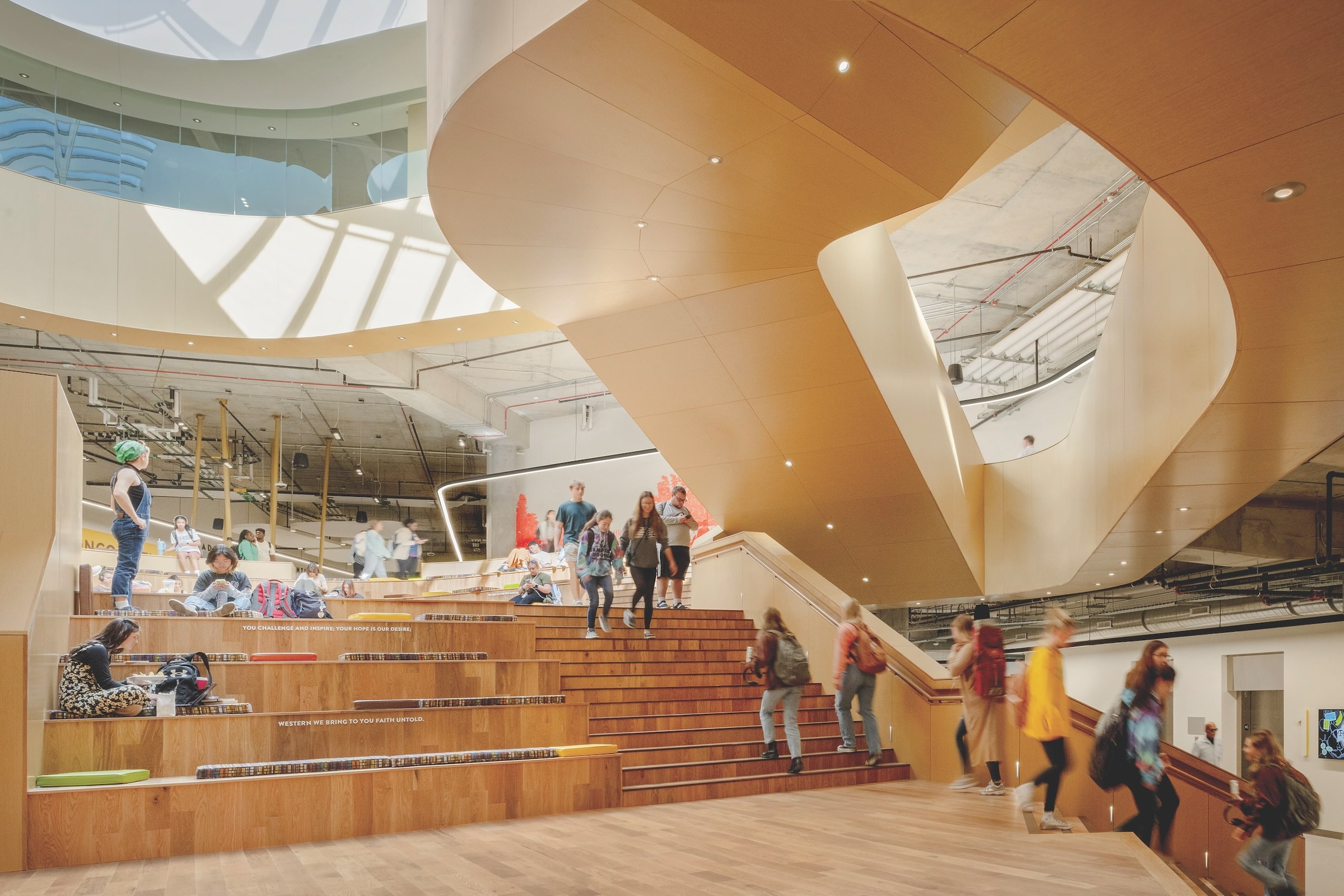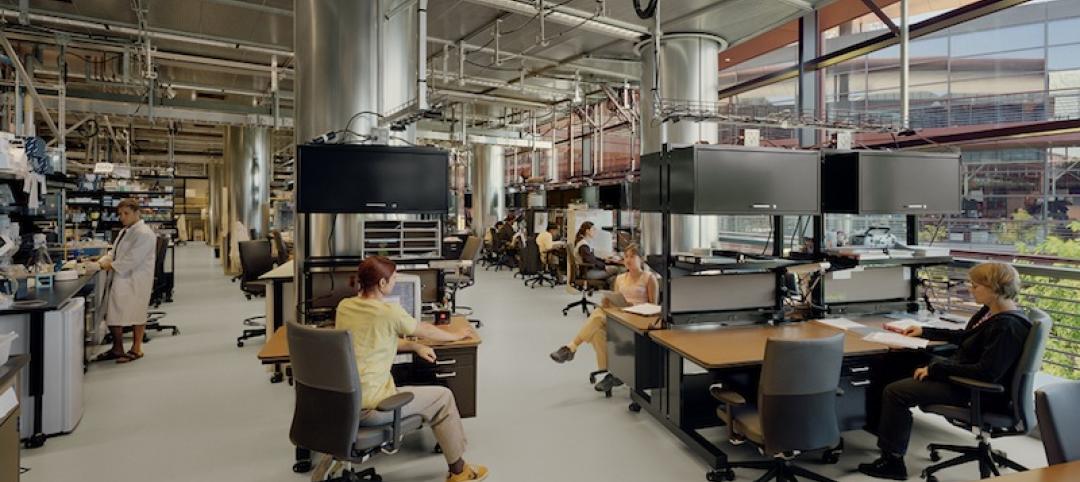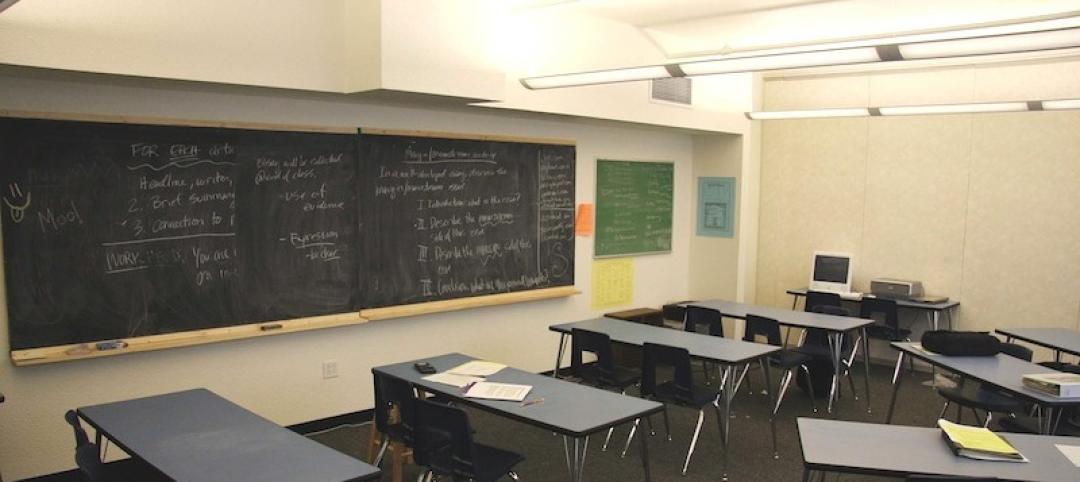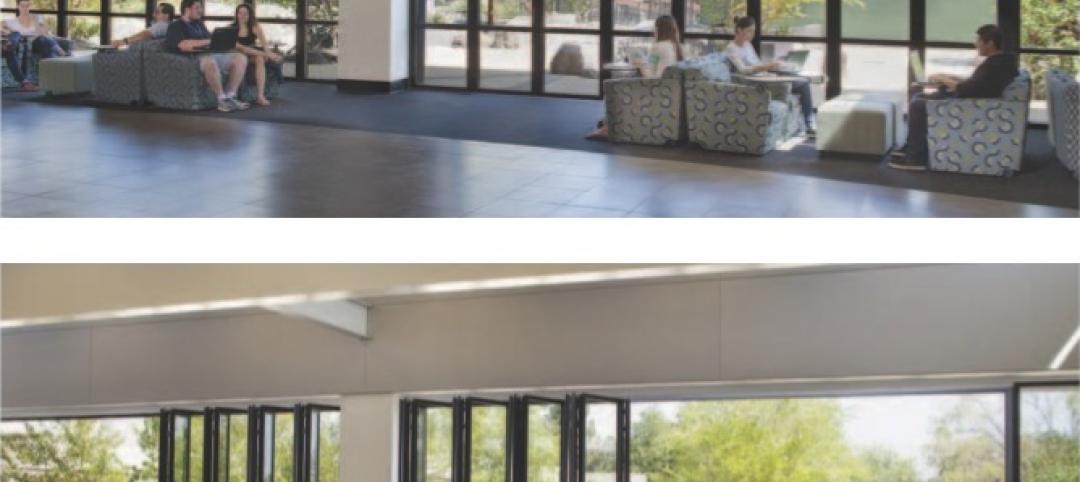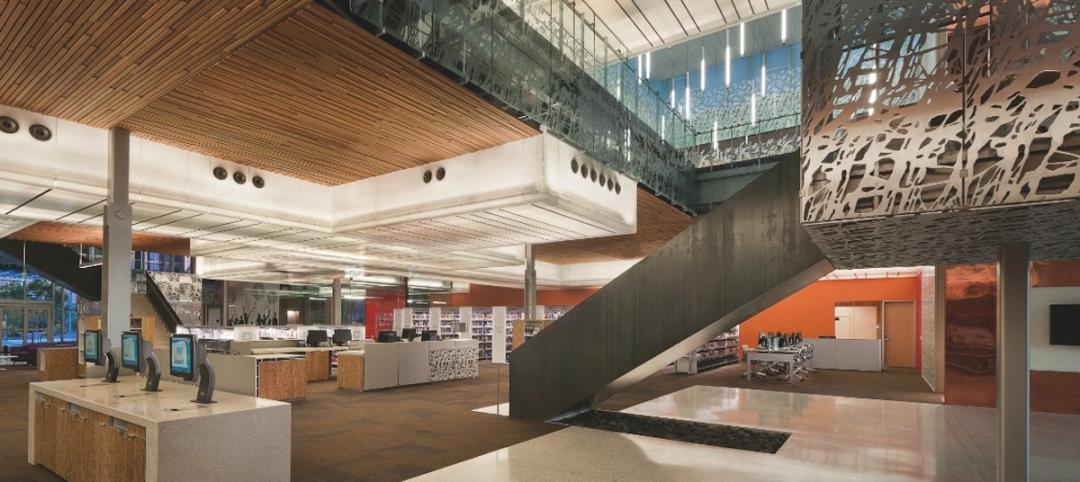One of Suffolk’s recent higher education construction projects is the Boston University Center for Computing and Data Sciences, a 19-story, 350,000-sf building that opened on December 8, 2022. Designed by Canada-based KPMB to achieve LEED Platinum certification, the center’s sustainable features include 31 geothermal bores, each 1,500-feet deep, that Suffolk and its subcontractor Skillings & Sons drilled to help provide the 300 tons of heating and cooling capacity for the building.
The center is also set five feet higher than the elevation the city requires to mitigate sea-level rise.
Sustainability and resilience now rival space flexibility as key design drivers for higher ed projects, according to AEC Giants with practices in that sector. “We’re seeing more and more focus on sustainable and resilient design across our project work, especially in states with legislation focused on that matter,” says Patricia Bou, CannonDesign’s Education Practice Director.
Bou alludes specifically to the California Institute of Technology Resnick Sustainability Center, a 182,000-sf mass timber makerspace for climate scientists, designed by the firm’s Yazdani Studio and scheduled to open this fall. The completed building will be surrounded by between 40 and 50 carbon-sequestering trees.
One of Skanska’s recent projects is Wake Tech Community College’s newest campus in Wendell, N.C., which includes a 15,700-sf Central Energy Plant and 297 geothermal wells. That heating and cooling system, completed last September, is engineered to use one-third less energy, and emit 50% less carbon, than traditional boiler/chiller HVAC setups, says Tieg Murray, Skanska’s Senior Director–Market Strategy. The plant also incorporates 283 rooftop solar panels and high-efficiency lighting.
There are business considerations behind schools positioning themselves as sustainability stewards. Murray quotes from The Princeton Review’s 2023 College Hopes and Worries survey, which polled nearly 8,800 college applicants; 69% of respondents said that having information about a college’s commitment to environmental protection would affect their decision where to apply. Twenty-eight percent of that cohort said having that information would influence their decision “very much” or “strongly.”
Consequently, sustainability is manifesting itself in all building types on campuses, say AEC sources. Last March, Williams College in Massachusetts unveiled designs by the firm SO-IL for a 76,800-sf purpose-built art museum that, when it opens in 2027, will require as little as 30% of the current baseline energy usage for art museums.
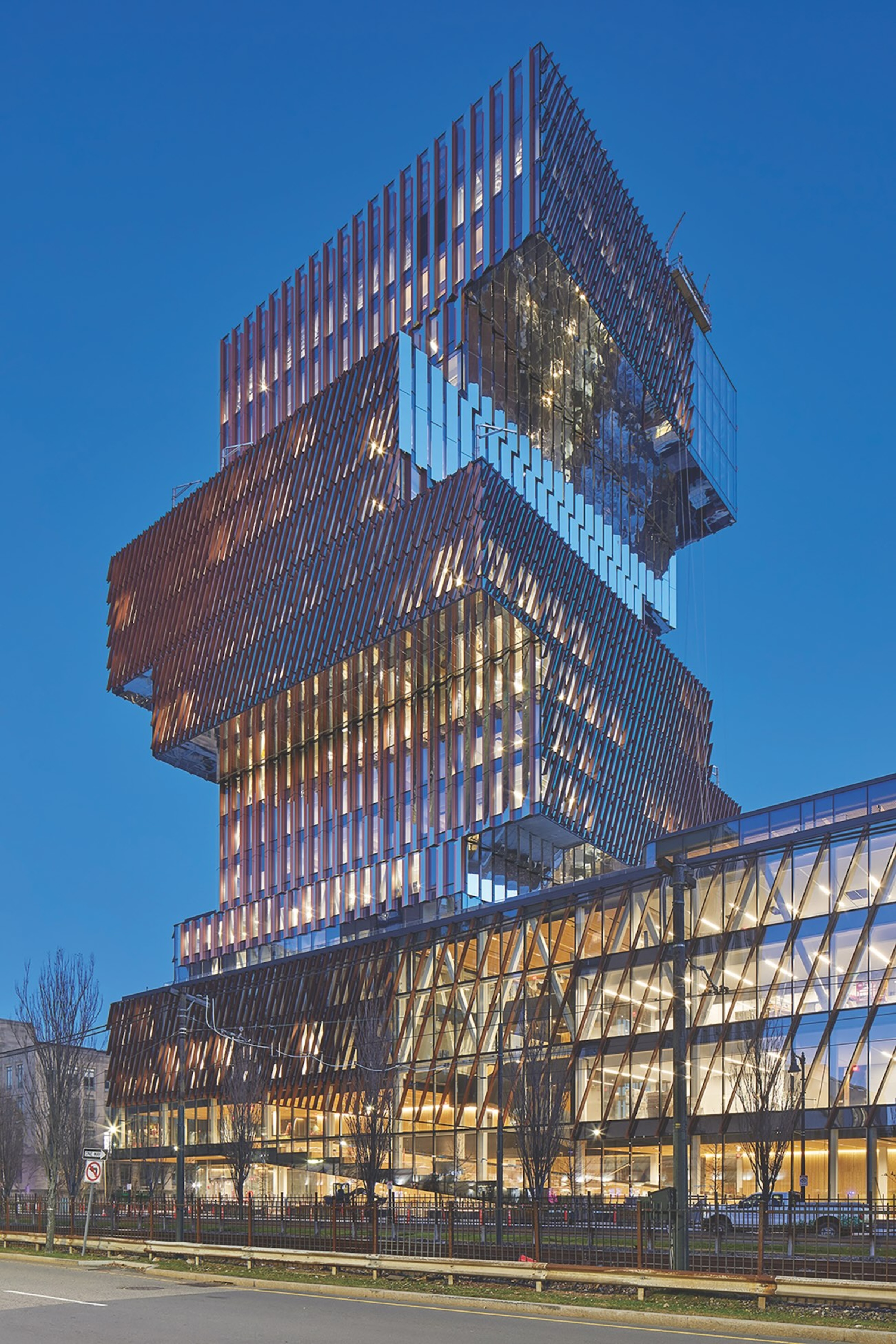
Lew Guerrette, Executive Vice President and General Manager for Skanska’s Seattle operations, adds that many of his firm’s higher ed clients now place “significant emphasis” on reducing carbon emissions by investing in energy saving technologies, retrofitting existing buildings with environmentally friendly features, and building new with sustainable materials. For example, the University of Portland’s 43,800-sf Shiley-Marcos Center for Design & Innovation, which Skanska completed last December, includes the campus’ first-ever solar array to power at least 24% of the building’s energy usage.
“There are aspects of sustainability and resilience in nearly every higher ed project we touch,” says Rick Humphries, PE, Senior Vice President and Director of Development for the engineering firm Salas O’Brien. The arc of that demand trend, he adds, can be traced back nearly two decades to the American College & University Presidents’ Climate Commitment, which Humphries says “lit a fire” under higher ed decarbonization initiatives.
That commitment led to investments for sustainable energy infrastructure, such as networked geo exchange energy systems and central energy plants of the kind that Salas O’Brien has been delivering for Princeton University’s new east campus, which provide 7,000 tons of cooling and 113,960 MBH heating capacity from a 583-bore geothermal system augmented by two 2.25-million-gallon thermal energy storage tanks.
Firms assume consulting roles
Given the complexity and costs of these systems, Humphries says that his higher ed clients’ “must haves” now include computational modeling to optimize systems performance, and an energy systems specialist with a thorough knowledge of available grants and tax incentives, financing options, and ownership models.
AEC firms often find themselves in consultative roles, advising higher ed clients about the best courses of action to take. “It is no longer enough to simply ‘check the boxes’ when designing and building campus buildings,” says Sean Edwards, Suffolk’s Executive Vice President and Division Manager. “Higher education clients are now more committed than ever before to making a positive, lasting impact on the environment for future generations.”
Page elevates its approach to building performance by leveraging its dedicated in-house building science team of architects, engineers, and analysts to develop and test integrated design solutions that prioritize economic and environmental objectives, says John Baxter, the firm’s Academic Market Sector Leader.
Gensler provided the Sustainability Plan for California State University–Northridge that includes Maple Hall, which opened in March, the first new building on that campus since 2009. The domestic hot water needs of this three-story, 62,475-sf academic classroom building are met by an air-source heat pump that supports the campus’ move toward electrification and eliminates combustible natural gas from the facility. (The engineering firm P2S provided MEP and fire protection design services. Gilbane was the builder.)
Door for reno opportunities opens wider
As The Princeton Review survey makes clear, sustainability can be a make-or-break selling point in schools’ recruitment and marketing efforts. Schools are looking for any competitive edge as student enrollment remains volatile.
Aravind Batra, PE, LEED AP, a Vice President and Principal at P2S, has observed that his firm’s higher ed clients are trying to counteract the specter of declining enrollment by, among other things, upgrading their facilities, and using advanced technologies.
Those upgrades encompass rightsizing and repurposing existing buildings for more efficient utilization. That probably explains why the AEC firms interviewed for this article have seen growing demand for research and lab projects, both in new construction and renovation.
In its 2023-2024 Almanac, published in August 2023, The Chronicle of Higher Education cites a National Science Foundation survey, which reflected 584 institutions. Respondents planned to start an aggregate of 10.6 million sf of new construction on research space in 2022-23, at a projected total cost of $12.8 billion. Over the previous decade, the amount of science and engineering research space at academic institutions had increased by 17%, or by more than 30 million sf.
The almanac also cites a survey of science and engineering research facilities that found 20% of all campus research space needed upgrades. AEC firms are taking advantage of these opportunities, such as the $38 million, 57,400-sf STEM building on the Menifee, Calif., campus of Mt. San Jacinto College, which houses science and math labs, lecture rooms, classrooms, and faculty offices. C.W. Driver Companies provided construction management services, and collaborated with DLR Group on this project, which was completed in June.
According to Guerrette, Skanska has 23 university science and research projects in the works in 11 states. These include the University of Virginia’s $236 million, 225,000-sf Paul and Diane Manning Institute of Biotechnology in Charlottesville, designed by Elkus Manfredi Architects, that is scheduled for completion in April 2027. The building will include a modular multi-use research lab for 100 to 150 investigators for a variety of disciplines.
Three-fifths of Skanska’s active higher ed projects are renovations, including the 55,000-sf modernization and 155,000-sf expansion of the University of Cincinnati’s Chemistry Building, which was first built in 1917. The addition incorporates new, open-bay chemistry research labs with chemical storage, material support, and faculty service space.
“With the federal government providing more R&D funding to higher education than any other sector, and with universities facing a competitive recruiting environment, there’s been no shortage of projects that include science or STEM, academic lab, and medical research,” explains Guerrette.
Student housing ripe for new projects
Another area where colleges and universities are targeting their modernization and expansion efforts is student housing and student unions. Schools are reacting to the rising cost of off-campus rentals—especially in urban markets—that can be a recruitment impediment and disincentive to retaining faculty.
On its Fort Wayne, Ind., campus, Purdue University is developing a 176-unit apartment complex with 600 beds to ease the pressure on its student housing, which has been at full capacity for the past six fall semesters. The four-story, 213,000-sf complex, designed by Progressive AE, will be built by Gilbane, which expects to start construction in October. When it’s completed in the fall of 2026, the complex will feature a convenience store, fitness center, gaming room, quiet study spaces, lounges, and multi-purpose spaces. Outside, it will have a hammock farm, green spaces, a sand volleyball court, basketball court, grilling areas, and fire pits.
McCarthy Building Companies is the CM/GC on San Francisco State University’s West Campus Green Student Housing and Health Center, a $142 million project that will provide 750 beds for first-year students. Scheduled for completion in February 2025, the project, designed by EHDD Architecture, was developed using a “pod” concept for bedrooms that provides space to socialize, sleep, study, and dine within a community grouping. The building’s Student Center will have its own entrance on the ground floor, and its programming will support a range of services, including a triage clinic, health and wellness, exam and treatment rooms, and spaces for admin and medical staffs.
“One critical way to attract new students is to provide more amenities and student housing options,” says Suffolk’s Edwards. That includes offering temporary living quarters that serve the school’s recruitment and events agendas. Cooper Carry’s Hospitality studio has developed a niche for designing hotels located near or on university campuses. For example, the Forum Hotel at the University of Virginia, which opened in April 2023, is an active component of the university’s Darden School of Business, with classrooms that support UV’s executive MBA program.
“University hospitality projects are typically viewed as extensions of existing learning experiences,” says Bob Neal, AIA, a Principal with Cooper Carry.
The focus on student unions, on the other hand, accentuates how schools are trying to keep their students on campus longer. One example of where these building types have been heading is the recently completed Student Center at Western Michigan University in Kalamazoo. Designed by CannonDesign, this three-level, 162,000-sf building is intended to serve as “a hub of belonging.” It includes gathering and lounge spaces, a dining facility, a bookstore, a welcome center, and retail locations. CannonDesign worked with Renee Wallace, a diversity, equity, and inclusion consultant, on this project’s design, which features elements of Native American culture.
Rejuvenating aging buildings
AEC higher ed Giants report working on a variety of building types, from performing arts centers and libraries to business schools. Hybrid learning is seemingly here to stay. And where possible, these projects address wellness and mental health concerns. “These spaces are often designed to enhance the student experience, encourage campus interaction through collaborative and community spaces, and to support both physical and mental well-being,” says Antonya Williams, Executive Vice President of Operations for McCarthy Building Companies.
More generally, renovation and expansion projects are addressing aging infrastructure that no longer meets student and faculty needs.
In a blog on higher ed construction trends, posted in June 2023, Mortenson observed that many residential buildings on campuses are old and lack amenities that students now prefer, such as private one-room studio apartments, or at the very least separate bedrooms and private bathrooms in dorms with communal living areas. Avin Kallenbach, Mortenson’s Education Market Leader, tells BD+C that these demand criteria are still relevant today, as aging infrastructure, outdated facilities, and decreasing enrollment all weigh heavily on higher ed clients.
The market research firm Gordian, drawing from its database of 43,000 campus buildings, has estimated that aging buildings account for between 30% and 40% of the space on college campuses. But 2023 was a bellwether year in terms of schools at least attempting to bring some of their building stock up to modern standards. Gordian’s 2024 State of Facilities in Higher Education estimates that investment in existing campus buildings grew by 33% from 2021 through 2023.
Several of Skanska’s university projects within the past year, says Murray, have been awarded as job order contracts, on-call construction, or IDIQ (indefinite delivery indefinite quantity) to upgrade buildings, reduce deferred maintenance, or improve campus operations. And an “increased focus on deferred maintenance challenges,” including envelope upgrades and interior space updates, is among the specific demands that Page is hearing frequently from its higher ed clients, says Baxter, its Academic Market Sector Leader.
Salas O’Brien’s higher education work is 75% renovation, says Humphries, its Director of Development, and prevalently so when it comes to a building’s HVAC systems. “Unless a university is building a new campus or an expansion, central energy facilities are more often renovated and expanded to introduce new technologies,” he says.
Related Stories
| Apr 5, 2013
Snøhetta design creates groundbreaking high-tech library for NCSU
The new Hunt Library at North Carolina State University, Raleigh, incorporates advanced building features, including a five-story robotic bookBot automatic retrieval system that holds 2 million volumes in reduced space.
| Apr 2, 2013
6 lobby design tips
If you do hotels, schools, student unions, office buildings, performing arts centers, transportation facilities, or any structure with a lobby, here are six principles from healthcare lobby design that make for happier users—and more satisfied owners.
| Mar 27, 2013
RSMeans cost comparisons: college labs, classrooms, residence halls, student unions
Construction market analysts from RSMeans offer construction costs per square foot for four building types across 25 metro markets.
| Mar 21, 2013
Are charter schools killing private schools?
A recent post on Atlantic Cities highlights research by the U.S. Census Bureau's Stephanie Ewert that shows a correlation between the growth of charter schools and the decline in private school enrollment.
| Mar 20, 2013
Folding glass walls revitalize student center
Single-glazed storefronts in the student center at California’s West Valley College were replaced with aluminum-framed, thermally broken windows from NanaWall in a bronze finish that emulates the look of the original building.
| Mar 15, 2013
Singapore R&D campus takes top honor in Lab of Year competition
Singapore CREATE R&D campus takes top honor in Lab of Year competition, sponsored by R&D Magazine.
| Mar 14, 2013
25 cities with the most Energy Star certified buildings
Los Angeles, Washington, D.C., and Chicago top EPA's list of the U.S. cities with the greatest number of Energy Star certified buildings in 2012.
| Mar 14, 2013
How to win more work from community colleges
The nation’s thousand-plus community college districts can be a steady source of income for your Building Team—provided you appreciate the special needs of this important sector of the higher education market.
Building Enclosure Systems | Mar 13, 2013
5 novel architectural applications for metal mesh screen systems
From folding façades to colorful LED displays, these fantastical projects show off the architectural possibilities of wire mesh and perforated metal panel technology.


